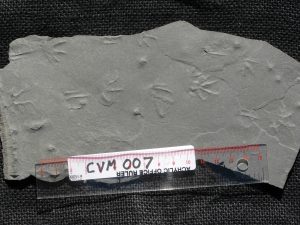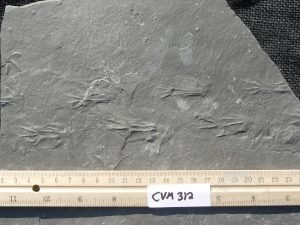
TUSCALOOSA, Ala. — It began as a fun and atypical father-daughter activity, but it soon became much more for one University of Alabama professor.Dr. Ron Buta, a professor of astronomy and physics, had long had an interest in paleontology, but he discovered something that he loved even more – astronomy. That was the field he pursued professionally.
Many years later, he rediscovered his fascination with paleontology. For 17 years, he has fostered that interest through research and fossil hunting trips. Now, he hopes to share what he has learned with others by donating his enormous collection of fossil trackways, or trace fossils, to UA Museum Collections.
“It belongs at a museum,” Buta said. “I can’t possibly study all of the tracks myself, but if I donate the fossils to the museum, then other people will have access and can research them.”
Fossil tracks, also known as ichnofossils, are preserved in a type of stone called shale. These fossils preserve the front and hind foot tracks of reptiles and amphibians, interactions between organisms, resting marks of invertebrates, fish fin and tail drags and even insect wings.
Buta’s discovery did not happen overnight. It was a journey that began when his oldest daughter was about 6 or 7 years old. He thought it would be fun to look for fossils together, and with the help of geologist Dr. David Kopaska-Merkel, of the Geological Survey of Alabama, Buta and his daughter went on their first fossil-collecting trip in South Alabama. He was hooked.

He joined the Birmingham Paleontological Society where he got to go on field trips and learn even more about paleontology.“As I looked into it more, I realized you could find plant fossils in Alabama that date back to the Coal Age, some 300 million years ago,” he said. “The whole existence of coal and the way the world was like at the time had something to do with continental drift and plate tectonics, and I realized that I could use that information in my astronomy class. We talk about terrestrial planets, and there’s a section on Earth. This gave me a way to connect the topic to Alabama specifically.”
Buta first saw fossil footprints during a 1999 meeting of the paleontology group. He and the other members had never seen anything like it before. The footprints were not dinosaur tracks, but rather very small, only about a centimeter across. When he looked at the slab, he could see what direction the animal was going and how many toes it had. The group learned that the tracks came from a site called the Union Chapel Mine.
What the group did not know was that these were not the first fossil footprints discovered in Alabama. In the mid-1920s, similar fossil tracks were found by miners in an underground mine in Carbon Hill, about 23 miles northwest of the Union Chapel Mine. Intrigued by the information, and while coauthoring a book on the tracks, Buta many years later decided to locate the site, but soon found that nothing was left of the old mine. However, just a short distance away, Buta noticed an active surface coal mine and asked permission to search the mine for these fossil tracks.
“The Crescent Valley Mine was right next to the old No. 11 mine, which means they are sampling the same rock layers that (Walter B.) Jones and (Truman) Aldrich were sampling in the 1920s,” he said.
During his first visit, he uncovered dozens of slabs, each with different sets of footprints. He wrapped each in bubble wrap and made plans to return. Over the last two years, Buta has made more than 30 trips to the mine, collecting more than 1,200 slabs of fossil tracks. He has also recorded and documented each find. Now, that information has been turned over to UA Museum Collections.
“This site is interesting because it is comprised of almost all vertebrate (reptile and amphibian) tracks,” said Dr. Dana Ehret, curator of paleontology. “It helps researchers ‘flesh out’ what Alabama looked like more than 300 million years ago, by giving us a rare glimpse at the behaviors of the animals and plants that lived there.”
Because it is such a large collection, it will take a while to unwrap and catalog the entire collection. Ehret said he will be looking for adult volunteers interested in helping curate the collection. Anyone interested can contact Ehret.
Buta is just relieved that it is finally in the museum “where it belongs.”
“This whole experience was just beyond belief,” he said. “It goes to show you that you don’t have to be young to rediscover an interest.”
Contact
Kim Eaton, UA media relations, 205/348-8325, kkeaton@ur.ua.edu
Source
Dr. Dana Ehret, 205/348-7425, djehret@ua.edu; Dr. Ron Buta, 205/348-3792, rbuta@bama.ua.edu